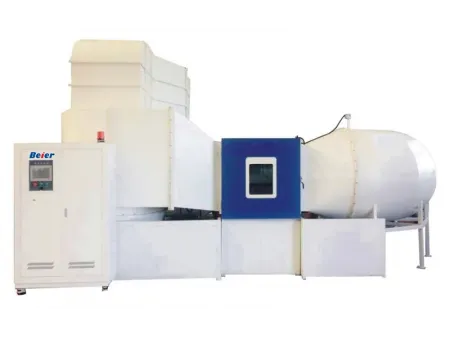Sand and Dust Test Chamber
Climatic test chamber used for measuring the effectiveness of products in sandy and dust-filled environments
Sand and dust test chamber adopts a high-power fan to blow a certain concentration of sand and dust over the surface of the test sample at a certain flow rate. The test chamber is used for evaluating the ability of test samples to resist the penetration of dust particles when exposed to sandy and dust-filled environments, the ability to resist abrasion from sand and gravel or cold blocking effects (airtightness), and their ability to store and operate.
Testing Type
Airtightness Testing/Abrasion Resistance Testing
Standards
Sand and dust chamber complies with standards: MIL-STD-810F, GB2423.37, GB/T4208.
- Sand and dust test chamber is widely used for testing the sealing performance of various products' enclosures, mainly for tests specified in protection class standards IP5X and IP6X. It is ideal for electromechanical equipment across various industries.
- Sand and dust test chamber is also used to simulate the damaging effects of sandstorms on products such as locks, automotive and motorcycle parts, seals, and electrical instruments.
- The sand and dust chamber is fully controlled by a touch screen, allowing real-time monitoring of test parameters such as temperature, humidity, wind speed, dust concentration, working time, and cycle periods.
- The memory function allows for automatic recording of the test time if a test is interrupted. Upon restart, it can accumulate time and resume the original test program without resetting. The test chamber stops automatically and gives audio and visual alerts when the test ends.
- Comprehensive safety and alarm devices include over-temperature protection, fan overheating protection, and power phase loss protection.
- The air intake comes with a rotary sand and dust feeding device to meet the need for sandblasting.
| Temperature Range | 20~ 80℃ | |
| Temperature Deviation | ≤±2.0℃ | |
| Temperature Fluctuation | ≤±0.5℃ | |
| Temperature Change Rate | ≥1℃/min (average, no load) | |
| Humidity Range | ≤30%RH | |
| Dust Blowing | Air velocity: 2(1.5~8.9)m/s Dust concentration: (10.6±7)g/m³ Dust particle size: 45um (75%), 75um (15%), 106um (8%), 150um (2%) | Optional |
| Sand Blowing | Air velocity: ≥(18~29)m/s (adjustable) Sand concentration: 0.18~2.7g/m³ (adjustable) Sand size: 850um (1%), 600um (1.7%), 425um (14.3%), 300um (37%), 212um (28.1%), 150um (12.7%), less than 150um (5.2%) | Optional |
Types of Sand and Dust Test Chambers
Sand and dust test chambers are optional in different sizes, from small sizes to large models for full vehicle testing. Common types include:
- Benchtop Chamber
- Reach-In Chamber
- Stackable Test Chamber
- Walk-In Chamber
- Drive-In Chamber
Tests Can Be Performed by Sand and Dust Test Chambers
Generally, the purpose of environmental testing is to ensure that products can operate normally under any conditions, thereby ensuring the quality of the produced products.
Sand and dust test chambers are used to simulate multiple testing conditions to meet various testing requirements, including:
- Highly Accelerated Stress Testing
- Highly Accelerated Life Testing
- Life Testing
- Production Monitoring
- Shock Testing
- Vacuum Testing
- Vibration Testing
- Temperature Testing
- Humidity Testing
- Thermal Shock Testing
- Electromagnetic Radiation Testing
- Low Pressure Testing
- Weathering Testing
- Corrosion Testing
- Condensation Testing
- Salt-Spray Testing
- Ingress Protection Testing
- Dust Protection Testing
- Water Protection Testing
- Radio Frequency Shielding Testing
